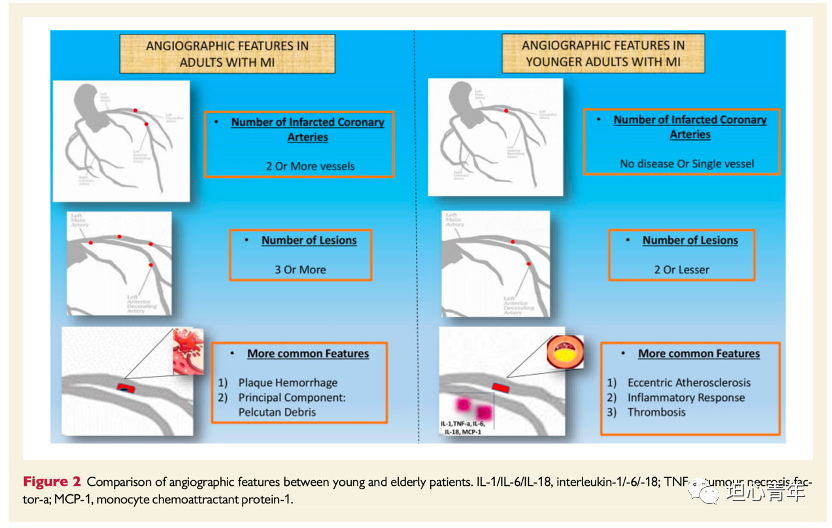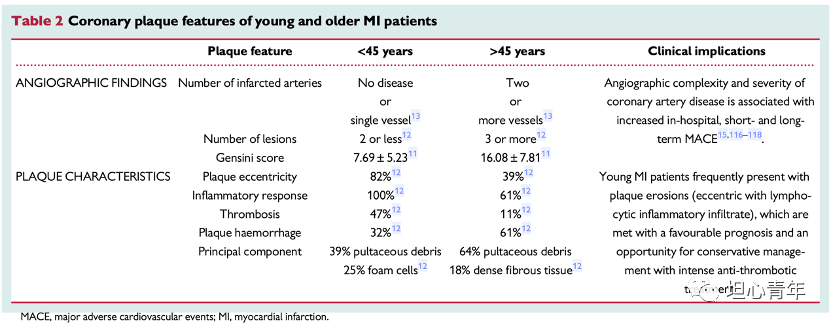

与老年人相比,年轻CAD患者的血管造影和病理解剖冠状动脉表现不同。左前降支(LAD)是两组患者中最常见的受累动脉。Gensini评分估计,年轻患者经常出现单血管CAD,冠状动脉病变较少,病变复杂度较低,这是成功恢复心肌灌注以及短期和长期不良心血管事件的有力预测指标。此外,Gensini评分是老年人长期死亡率的独立预测指标。
就组织学表现而言,与老年MI患者相比,年轻患者更有可能出现偏心病变、大中型冠状动脉淋巴细胞浸润和血栓形成。具体而言,82%的年轻患者患有偏心性动脉粥样硬化,所有患者都观察到炎症反应。相反,39%的老年人检测到偏心动脉粥样硬化模式,而炎症的存在随着年龄的增长而减少。斑块出血在年轻受试者中不太常见(32%对61%在老年患者中)。牙髓碎片是两组患者动脉粥样硬化斑块的主要成分,在老年人中更常见,而泡沫细胞和纤维组织在两组患者中都很常见。
这些发现表明,年轻的MI患者经常有侵蚀性斑块,其特征是离心率和淋巴细胞浸润。炎症和斑块内出血是老年人易受感染的薄壁纤维动脉粥样硬化瘤形成的主要机制之一,导致斑块破裂和MI。有趣的是,这些斑块形态的改变导致了不同的临床表型。年轻患者的MI事件更常见于斑块侵蚀,而老年患者的斑块破裂更常见。此外,与老年受试者中更常见的破裂斑块相比,斑块侵蚀与年轻MI患者中不太复杂的LAD局部动脉粥样硬化模式以及更好的预后有关。
最后但并非最不重要的是,与年轻MI患者一样,斑块侵蚀的存在具有重要的治疗意义,因为在一项针对有斑块侵蚀证据的急性MI患者的小型临床研究中,采用无支架、强化抗血栓方法,在随访4年后,可显著或完全消除血栓,并免于发生不良心脏事件。
斑块侵蚀的生物标志物的发现可能最终导致非ST段抬高型心肌梗死患者的非侵入性管理,这可能会指导治疗决策,使其转向针对性的强抗血栓方案治疗。

Coronary plaque features—Differences between elderly and younger MI patients.
Angiographic as well as pathologoanatomical coronary findings are different in younger patients with CAD compared with the elderly (Table 2 and Figure 2). The left anterior descending (LAD) is the most commonly affected artery in both patient groups. Younger patients frequently present with single-vessel CAD, fewer coronary lesions, and lower lesion complexity, as estimated by the Gensini score, which is a strong predictor of successful restoration of myocardial perfusion as well as short- and long-term adverse cardiovascular events. Moreover, Gensini score was an independent predictor of long-term mortality in elderly individuals.
With regards to histological findings, younger patients were more likely to have eccentric lesions, as well as lymphocytic infiltration of large- and medium-sized coronary arteries and thrombosis compared with older MI patients. Specifically, 82% of the young patients had eccentric atherosclerosis with an inflammatory response being observed in all of them. On the contrary, an eccentric atherosclerotic pattern was detected in 39% of the elderly, while the presence of inflammation declined with ageing. Plaque haemorrhage was less common in young subjects (32% vs. 61% among older patients). Pultaceous debris, the principal component in atherosclerotic plaques of both groups of patients, was more common in the elderly, whereas foam cells and fibrous tissue were common in both patient groups.
These findings suggest that young MI patients frequently have eroded plaques, characterized by eccentricity and infiltration by lymphocytes. Inflammation and intraplaque haemorrhage are among the main mechanisms of vulnerable thin-cap fibroatheromas formation in the elderly, leading to plaque rupture and MI. Interestingly, those alterations in plaque morphology lead to distinct clinical phenotypes. An MI event in young patients is more frequently caused by plaque erosion whereas plaque rupture is more often detected in older patients. Moreover, plaque erosions have been associated with a less complex, LAD-localized atherosclerotic pattern as in the case of young MI patients and a better prognosis compared to ruptured plaques, which are more frequently found in elderly subjects.
Last but not least, the presence of plaque erosions, as in young MI patients, has important therapeutic implications since a stentless, intensive anti-thrombotic approach in a small clinical study of acute MI patients with evidence of plaque erosion led to significant or complete thrombus resolution and freedom from adverse cardiac events after 4 years of follow-up.
The discovery of biomarkers of plaque erosion may ultimately result in a non-invasive management of patients with non-ST-elevation MI may guide treatment decisions towards an individually tailored treatment of intense anti-thrombotic regimens.